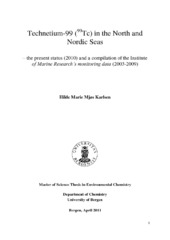| dc.description.abstract | Technetium-99 (99Tc) is an anthropogenic, pure β-emitting (Emax = 292 keV) radionuclide with a half-life of 2.13 · 10^5 years. It is present in the marine environment primarily due to discharges from nuclear fuel reprocessing facilities and global fallout from nuclear weapons testing during the 1950s and 1960s. During the period 1994-2004, large amounts of 99Tc were discharged into the Irish Sea from the nuclear reprocessing plant Sellafield (UK). Technetium-99 (as the highly soluble pertechnetate ion, TcO4-), is transported by ocean currents from the Irish Sea to the North Sea and Skagerrak, and further northwards to the Norwegian and Barents Seas via the Norwegian Coastal Current (NwCC). In July/August 2010, 20 surface seawater samples from the North Sea, Skagerrak and the NwCC were collected during a cruise aboard R/V Johan Hjort. The first radiochemical separation step (addition of rhenium (Re) as yield monitor and preliminary anion-exchange) was performed aboard the ship. The subsequent radiochemical analyses were carried out at the Chemistry Laboratory of the Institute of Marine Research (IMR). The analytical method is based upon Harvey et al. (1992). After iron hydroxide scavenging, 99Tc and Re were further extracted by a second anion-exchange separation and subsequent sulphide precipitations. Finally, their tetraphenyl arsonium salts were isolated. The yield of the rhenium tetraphenyl arsonium salt was determined gravimetrically, and 99Tc was beta-counted using a RISØ low-level beta-counter. The 99Tc activity concentrations ranged from 0.12±0.01 to 0.77±0.04 Bq m-³, with a mean value of 0.33±0.14 Bq m-³. The maximum 99Tc activity concentration was measured in a sample collected off the east coast of Scotland. The 99Tc level in the NwCC (mean activity concentration 0.34 Bq m-³) was a factor of 2 lower than the concentration observed off the Scottish coast. The lowest activity concentrations were found in samples from the north-western part of the North Sea with high influence of inflowing high salinity, radionuclide poor Atlantic water. A compilation of IMR's historical monitoring data (2003-2009) on 99Tc in the North and Nordic Seas was performed in order to investigate trends. Data from an IMR/CEFAS (Centre for Environment, Fisheries and Aquaculture Science) study (1998-2000) was also included. Overall, the results show that the 99Tc activity concentrations in the North and Nordic Seas are generally decreasing following the reduction in the discharges from Sellafield. | en_US |
